#len'en jinbei
Explore tagged Tumblr posts
Text

the punishment god's favourite puppets
#lenen#len'en#len'en horror au#yabusame houlen#tsurubami senri#jinbei#lenen jinbei#len'en jinbei#tw body horror#my art#i am so insanely proud of this#like VERY PROUD#it looks so cool...
24 notes
·
View notes
Text
anniversary yippiee yahoo

40 notes
·
View notes
Text

feel sleepy
21 notes
·
View notes
Text


Dumbass dnd character and jinbei from uwom
13 notes
·
View notes
Text

3/10 is Mitori day
#len'en#len'en project#ooama no ake no mitori#tw blood#cw blood#it's still the tenth in my timezone#i was drawing a jinbei one too but that one won't make it i think#mysterious origin “ink and silver”
21 notes
·
View notes
Note
Hi there! I remember in one of your previous analyses that you'd love an opportunity to talk about shikigami (I think). As someone who is also quite curious about it, would you mind divulging on the subject?
Oh of course, thanks for reminding me!
Shikigami: From History to Len'en
Shikigami, like barriers (which I also did a Len'en-focused analysis on), is one of those things I feel like many who are into Japanese media, especially traditional fantasies, have a general idea about, yet don't really have a grasp on their real-life conception and history.
So, just like in the barriers post, let's take a look at what shikigami are all about, in real-life history and in the Len'en series!
Origins of Onmyōdō
To understand the origins of shikigami, we first have to have a cursory understanding of the complex art of Onmyōdō (陰陽道 lit. "the way of Yin and Yang").
Roots in Chinese Philosophy
Onmyōdō, as we understand it, has its roots in the Chinese philosophical Theory of Yin-Yang and the Five Phases (陰陽五行思想).
Yin and Yang (陰陽) can be described as the fundamentally opposite but interconnected forces that constitute as well as cause change in everything in the universe.
The Five Phases (五行) is a conceptual framework which is used to classify and explain a wide array of phenomena, including the movement of celestial bodies, the interaction between internal organs to, the rise and fall of political regimes and the properties of medicine, amongst other things. The five phases are, in order, fire, water, wood, metal, earth.
The Theory of Yin-Yang and the Five Phases then combines the two, and was associated with and used for a variety of (what were at the time considered) natural sciences, such as astronomy, calendar making, time keeping and divination.
Development in Japan
When transmitted to Japan alongside Confucianism, Daoism, Buddhism, it was accepted by the Japanese people as having actual power, and its associated practices like divination and manipulating fortune were accepted as well.
As these beliefs and practices fused with the native Japanese beliefs (what one may classify as Shinto) and Japanese Buddhism (remember that Buddhism also had its own major developments in Japan), a system of beliefs and practices that were uniquely Japanese was born.
This was Onmyōdō, and it was a state-controlled craft. Onmyōji (陰陽師 lit. "master of yin and yang") were the practitioners of this craft who belonged to the Bureau of Onmyō (陰陽寮), and they offered their services to the royal family and the noble elites.
The Historical Shikigami
Examining the Word "Shikigami"
Now that we can finally take a look at the historical shikigami. They are known by a number of names: shikigami/shikijin (式神・識神), shiki-no-kami (式の神・識の神), shi-ki (式鬼) or shiki-kishin (式鬼神).
No matter the rendering, there is a common element throughout most of them: 式 read shiki or just as shi. It means "to make use of", and refers to the onmyōji's control over these beings.
The specific beings that these names list are kami (神 gods/spirits), oni (鬼) and kishin (鬼神). The last term refers to a myriad of concepts, from wild and rampaging kami to divine spirits to any supernatural thing that causes mysterious phenomena.
Below: Famous onmyōji Abe no Seimei (in black) accompanied by two of his shikigami (below Seimei).
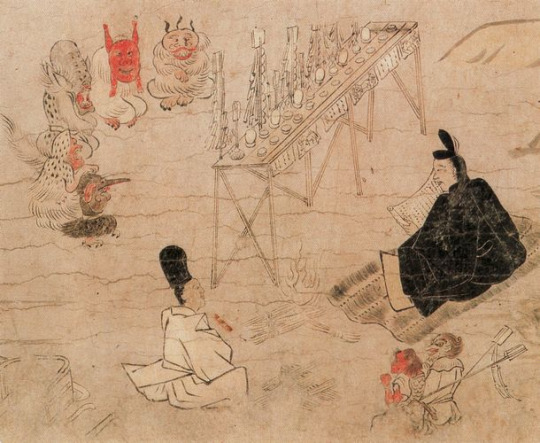
So, from the name, we can tell that shikigami refers to the gods, spirits, supernatural beings and even just supernatural forces under the onmyōji's control. Additionally, it is said that the process through which an onmyōji summons these spirits is also called shikigami..
Types of Shikigami
Shikigami are in fact invisible to everyone except their master, but can take on forms that are visible to the average person. In general, shikigami can be classified in to two ways:
One is according to the form they appear in, such as human-shaped (人型), bird/beast-shaped (鳥獣型), youkai-shaped (妖怪型), etc.
More interesting, perhaps, is classifying them based on how they were created:
First are "mental-action shikigami", (思業式神 shigou-shikigami) they are manifested through the onmyōji's thought, and are said to directly reflect their master's ability.
Next are "personified shikigami" (擬人式神 gijin-shikigami), they are produced by imbuing a doll, often made of paper, straw or plants, with spiritual power. Those which obtain a will of their own are considered higher-rank, while those that do not are considered lower-ranked.
Below: A straw doll used to summon a shikigami into.
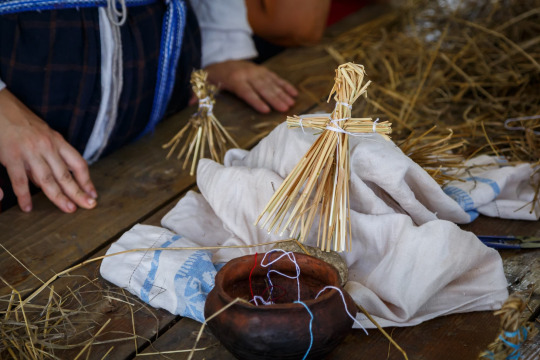
Final final type are called, literally, "gods of evil deeds and revealed retribution" (悪行罰示神 akubyoubasshi-kami). It's rather unwieldy and not exactly clear what it means.
So instead, I'll call these "shikigami through karmic retribution". They are typically beings who committed evil deeds in the past who are defeated and subjugated by onmyōji, becoming their shikigami.
The final type, perhaps obviously, are considered particularly dangerous, as an unskilled master can be overpowered by the shikigami, allowing it to cause harm to its master and others.
Functions of a Shikigami
Basically, there's nothing a shikigami cannot do, as they are (provided that the onmyōji is powerful enough) completely bound to the will of their master.
Here I'll just briefly list a few of what shikigami were said to be used for throughout history and myths:
Defeating harmful and devil spirits
Possessing someone to cause them harm
Placed at key locations as protector deities
Pass on messages and deliver objects
Reconnaissance
Housework, house-watching and personal care
Yeah, basically anything you can think of.
Onmyōdō in the Present Day
Persistance and Development
Onmyōdō and onmyōji, along with the Bureau of Onmyō, persisted throughout Japanese history, slowly gaining popularity amongst the general populace as well. It has its ups and down, even losing its official status once, but it never faded away.
One particularly famous Onmyōji that should not go unmentioned is Abe no Seimei (安倍晴明), said to be a genius in the art. Many of his exploits are left behind as legends, and he himself is a popular topic of many modern fiction stories.
Below: Mitori's Pentagram "Bellflower Seal Crush", based on a seal of the same name invented by Seimei to ward off demons.

Fall and Modern Status
It was not until the after Meiji Revolution, in 1870, that the new government passed a bill to ban Onmyōdō as a superstition, under the support of pure Shintoists and the exclusionists, who rejected Onmyōdō based on its Chinese roots.
After this, the Onmyōdō of old basically disappeared from Japanese society. Later, when the ban was lifted, Onmyōdō was already reduced to a point where it would never return to the level of prestige and power it once held during the Heian period.
Nowadays, there are two schools of Onmyōdō left, the "Tensha Tsuchimikado Shinto" (天社土御門神道) and the Izanagi School (いざなぎ流).
Tensha Tsuchimikado Shinto
This school was established by a family that traces it lineage back to Abe no Seimei, the Tsuchimikado Family.
Thanks to its fusion of Onmyōdō and Shinto, it was able to survive the ban on Onmyōdō by leaning on its Shinto side. Though it would lose official support regardless and turn to private practice.
The Izanagi School
A unique folk religion developed independently in the archaic Tosa Province (modern day Kōchi Prefecture). It has elements of Onmyōdō belief and practice, but aren't recognised by Tensha Tsuchimikado Shinto.
Popular Culture
The colourful stories of onmyōji from various legends, especially of them binding youkai to their control and excercising other mystical powers, captured the popular imagination and lead to a myriad of fictional depictions of them.
It is here that the most common depiction of shikigami emerges, as youaki bound by onmyōji, or spirits summoned into paper dolls by them. And it is here that we loop back to Len'en.
Shikigami of Len'en
The most info on shikigami in the Len'en series can be found in Garaiya Ogata's BPoHC profile:
A shikigami receives spiritual power from its master, and can act using the accumulated spiritual power from them. How much spiritual power they can save up and what they can do with said accumulated power varies from shikigami to shikigami. [...] However, the master's spiritual power is naturally limited. [...] However, since a slight amount of their master's power is constantly consumed to keep their shiki up and running. Multiplying too much will overburden their master, ultimately deactivating the shiki.
It would seem that shikigami run on a fairly unique set of rules in Len'en, that of an exchange and balance of spiritual power between master and subject.
The master needs to use their power to somehow activate and maintain a shiki contract with the subject, which creates a link between the two and allows the subject to draw on their masters power. In the case that the master runs out of power, the contract immediately deactivates.
The amount of spiritual power a shikigami stores seems to be somewhat proportional to how powerful they are, as seen in Kuriju Kesa being technically weaker than Kaisen Azuma, but still seen as more useful thanks to the former being better at storing spiritual power from Garaiya.
We don't really know much else about shikigami in the series, though there are a few things that we can speculate upon.
Bound Evildoer Shikigami
First we can examine the most prominent master-shikigami pairs, that between Garaiya and Kaisen & Garaiya and Kurjiu.
Below: Garaiya with Kaisen and Kujiru in animal form.

It's possible that these two are what I called "shikigami through karmic retribution", as they were apparently "pretty mischievous" in the past, prior to meeting Garaiya.
This is particularly likely with Kaisen, as one of their inspirations, the Chinese mythological creature known as Jinchan (金蟾 Lit. "gold/golden toad"), actually has pretty much this play out, just framed under Daoism instead of Onmyōdō.
In the folktale Liu Hai Tricks Jinchan (劉海戲金蟾), it is said Liu tamed a malevolent and greedy three-legged toad after fishing it out of the east sea. It became Jinchan and was henceforth the immortal's companion, following Liu wherever he went.
So yeah, basically "evil youkai does bad deeds" → "good person comes around and tames it" → "evil creature now serves the good person somehow".
With Kujiru, it's not as direct, since their basis, Kesa-gozen (袈裟御前), was the victim in her story, rather than the villain or a villain redeemed. Still, if JynX wanted to somehow collapse both the villain and the victim into one, they certainly can, so I can't really say that this disproves Kujiru as a "shikigami through karmic retribution".
Bonus Note: Jinbei
There's really not enough information on Jinbei to say much about them as a shikigami, but it's interesting to note that they don't (or at least don't only) draw power from their master.
Rather, they draw power from and supply power to the Mugenri Barrier, the current Senri priests (Yabusame and Tsubakura) as well as a yet undisclosed source.
On a personal note, Jinbei gives me the vibe of a spirit that was summoned into an object. Similar to the personified shikigami, though not summoned into a doll, but into the very jinbei that they're always wearing.
Conclusion
There's still much that we don't know about shikigami in Len'en, so other possibilities still exist with both Kaisen, Kujiru and Jinbei.
For example, Kaisen and Kujiru can also be spirits summoned into the youkai, akin to how the Touhou series conceptualises its shikigami. Or Jinbei could be a youkai who's subjugation contract is renewed with every new Senri priest.
Basically what I'm saying is that canonically all we have is the Garaiya profile and the two related 2021 interview answers that I've linked.
In any case though, I hope you at least got something out of the first part about the historical shikigami, and how they are classified and used even to this very day.
As usual, I hope you enjoyed~! :)
#len'en#len'en project#len'en lore#garaiya ogata#kujiru kesa#kaisen azuma#jinbei#jinbei len'en#shikigami#I tried to find english translations for these terms#but like I said#well known in popular culture but not in its historical understanding#so it was difficult to find much about this in english#I'm leaving the “jinbei” tag there#maybe this'll be interesting for the traditional Japanese fashion crowd#who knows?
21 notes
·
View notes
Text

me and my employer
2 notes
·
View notes
Note
How are the Len'ens at punctuality?
Not great, to put it simply. I don't see too many of them as having punctuality in their wheelhouse lol.
It would be easier to say who isn't routinely at the very least five minutes late. Though the worst offender to this is easily Tsubakura. Schedule something for them, and they will show up three days after like it's no big deal. Yabusame and the younger Shitodos are pretty big offenders too. Though they at least have the decency to show up the same day you ask them to.
There are some early birds though. Souko, Para, Kaoru, and Jun all usually show up at least twenty minutes early (though Kaoru is prone to showing up two hours earlier than intended). Garaiya tries to be this, but they're usually pretty late nevertheless due to a certain pair of shikigami. They always apologize profusely for it when they do show.
And then you have the people who show up exactly on time. Sanra, unlike Mitori, is usually gonna show at 5 o'clock sharp if you ask them to. Kuroji, unlike their lazy siblings and Tsubakura, is unfortunately also almost always on time. They also dislike people being late, as an added kicker.
And then there's the couple of people who are weird about it. Jinbei has a penchant for magically showing up right at the exact minute they're expected. They swear that's not the case, but many people have their doubts. And while they don't get to demonstrate it often, Saragimaru has a similar habit of appearing out of thin air when they're expected. Usually right behind you for some reason. It's pretty creepy actually, but they usually brush it off as a force of habit if you were to ask (and dislike being prodded any further on it).
Everyone else I didn't mention are a bunch of late bastards most days. That is all.
#I've been spotted! (inbox)#len'en#len'en project#tsubakura enraku#yabusame houlen#hooaka shitodo#aoji shitodo#souko shirami#para#kashiwagi kaoru#jun amanomiya#garaiya ogata#fujiwara no shirogane no sanra#ooama no ake no mitori#kuroji shitodo#jinbei#adagumo no saragimaru#Mugenri has very lax rules on punctuality I guess#but honestly it's mainly because I find it funnier this way#(yikes that's a lot of characters)#(I apologize for nothing)#(except maybe clogging up the tags)#orange and her bizarre len'en headcanons
10 notes
·
View notes
Text
For political reasons, Senri Shrine priests have to get married to someone outside of the shrine. As it turns out, this applies to temporary priests too. Luckily, Tsubakura and Yabusame know exactly who they're going to marry.
#len'en fanfiction#len'en#len'en project#yabutsubakuro#kuroji shitodo#jinbei len'en#tsubakura enraku#yabusame houlen
7 notes
·
View notes
Text
It is JINBEI DAY!
In Len'en Project, Jinbei is a character mentioned briefly in games and only partially being seen in Reactivate Majestical Imperial. They're a kinda important guy as a shikigami that helps out the new Senri preists, Yabusame and Tsubakura, with their preistly business and sending them out to solve incidents, but doesn't serve much of a purpose for gameplay.
Back in 2017, JynX, creator of Len'en, held a poll to determine what information he would reveal relating to the lore and games, and revealing what Jinbei looks like was the winning option. That happened 6 years ago today! We have not gotten another full drawing of them since. [Link to image source]

[ID: A digital drawing of Jinbei from the Len'en Project series. They have pale skin, grey eyes, black hair tied into a high ponytail, and bandages wrapped around their forehead. They wear a short single-layer black-and-green jinbei-haori with detached sleeves. Jinbei sits on top of a torii in front of a staired path, a couple of books and tea to either side of them. /End ID.]
This isn't the Coolest Thing bout Len'en but its top of my mind rn :D
11 notes
·
View notes
Text

I realize the futch scale has fallen out of favour and what not but like. Len'en futch scale
Ramble under the cut
Made this for me and me alone, as my headcanon is that all the Len'ens without a set gender are all the same gender. What that is depends on my mood but it's usually between non-binary and male
This is much more a "feminine to masculine" scale than a futch scale, so my apologies
This is mostly based on my headcanons, which in turn is based on that one gender survey a long time ago
(Also ALSO this is rabbit-of-mugenri's new account, 'cause I can't log in to that account anymore ;_;)
Stone Butch (very masculine): Kurohebi, Clause, Hibaru, Kunimitsu
Butch (masculine): Aoji, Hooaka, Kuroji, Shou, Lumen, Medias, Kujiru, Kaoru, Garaiya, Yago, Jinbei
Soft Butch (somewhat masculine): Tsubakura, Yaorochi, Iyozane, Kaisen
Futch (androgynous): Tenkai
Butchy Femme (somewhat feminine): Yabusame, Sese, Tsugumi, Chouki
Femme (feminine): Suzumi (Hamal Cine), Tsurubami, Sukune, Saragimaru, Fumikado, Mitsumo(?), Sanra, Para, Mitori, Haiji, Terumi
High Femme (very feminine): Jun, Shion, Souko, Xeno a
#len'en#lenen#so my actual headcanon is pretty close to this#but with kujiru and especially yaorochi more femme#and shion a wee bit more butch
9 notes
·
View notes
Text
Okay workin on the list of lads to include in the poll and I wanna get some input
To clarify the basis of this poll is gonna be "Who would create the stupidest fucking discourse" and I'm calling is Mugenri's Most Problematic cus I like the way it sounds. With that outta the way:
So far I am excluding fellas that essentially don't have Official Art in the sense of a full body, full color, high res image, so no EmEv guys, Haru, or Hoojiro. I'll also be excluding Terumi cus we dont know very much about them, they'll jus be lumped in w Mitsumo.
I'll include Jinbei, as well as NILU and Tom solely bc I wanna see Tom in this so bad and those two cant be separated. Not including Lin cus that means I'd have to add or remove someone else and like. They only got 1 vote in the Len'en Popularity poll so I don't think anyone should be too butt hurt.
#mod sukune#not quote#if anyone got any objections to who I'm not including feel free to yell at me (nicely I will cry (no I wont)) in my inbox or comments
6 notes
·
View notes
Text
skibidi toilet
skibidi toilet yabutsuba (do NOT ask me why)

#len'en#tsubakura enraku#yabusame houlen#shion#jinbei#im normal i swear my humor is not broken whatsoever#also i gotta be real i never watched skibidi toilet and im not planning on ever doing that thank you very much
19 notes
·
View notes
Text
art dump pt4
Body horror since it kinda pertains to @tsubakura-enraku's Len'en Horror AU but its my cringe self-shipping so 👍
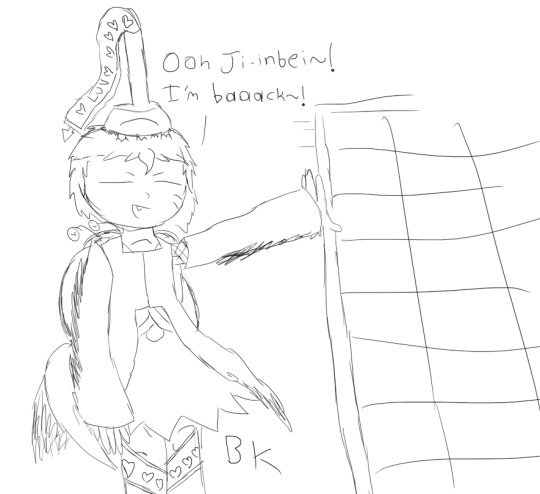
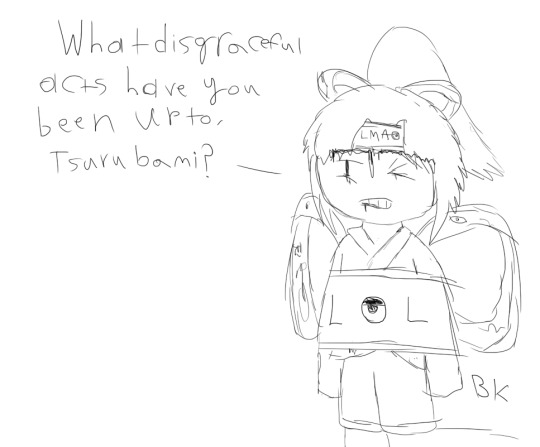
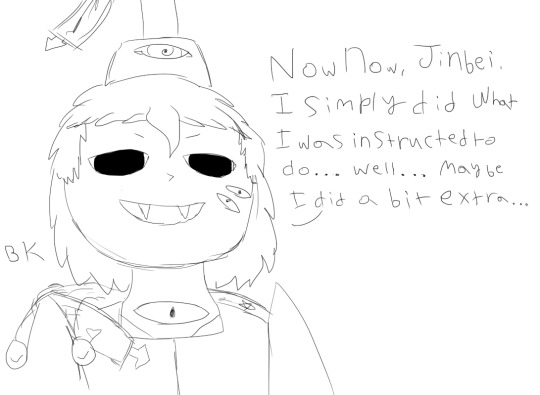
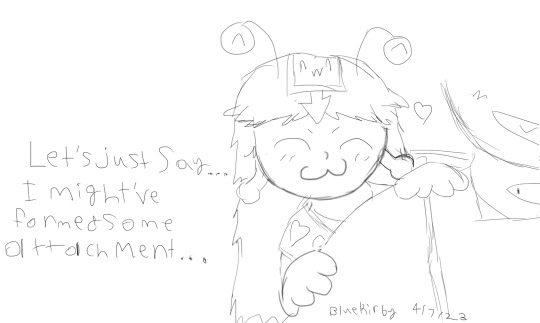

Transcription (sorry if I do anything wrong):
Panel 1, Horror!Tsurubami: *holding Slippi* "Ooh Ji-in~bei! I'm baaack~!
Panel 2, Jinbei, tied up (their talismans say "LMAO" on their head and "LOL" on their body): What disgraceful acts have you been up to, Tsurubami?
Panel 3, Horror!Tsurubami: Now now Jinbei, I simply did what I was instructed to do... Well... Maybe I did a bit extra.
Panel 4, Slippi smiling, revealing herself from behind Horror!Tsurubami. Horror!Tsurubami speaking: Let's just say... I might've formed some attachment...
5th image is just the entire comic in one page.
5 notes
·
View notes
Text

new senri vessel?
#len'en#lenen#len'en horror au#tsubakura enraku#lenen jinbei#len'en jinbei#horror!tsuba#i spent way longer on this#than i thought i was going to#tw body horror
13 notes
·
View notes
Text

Good at cooking.
14 notes
·
View notes